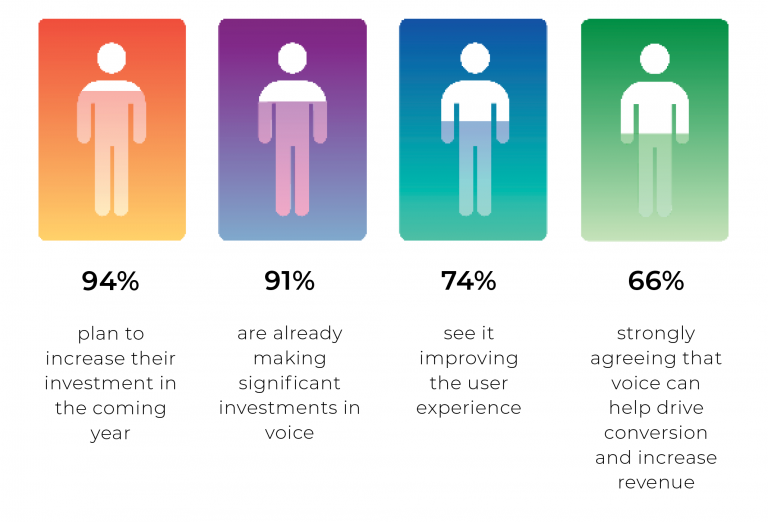
Technology has taken a quantum leap in every aspect of our lives and everything we do today. The digital salience of modern technology will continue to dominate the way we do business and the everyday interactions we perform. One of the transformative products of technology is voice tech and its application in the business process. In a world that fears touch, voice technology is gaining unprecedented momentum. This, in turn, is radically reshaping consumer habits and preferences on a global scale.
Consumer adoption of voice technology is seamlessly increasing and is set to disrupt the way people buy products and services. There is an opportunity for businesses to leverage this burgeoning space for their customers and clients to make their lives easier, smarter, and less stressful. Google has researched with people who own smart speakers on why they prefer voice-driven solutions for their needs. They found out the following
- It makes life easier - Because it's quick and more convenient than typing, leaving ample room for multitasking. Consumers are looking for innovations and personalized solutions that make a remarkable difference in their life
- Easier accessibility
- It’s part of the daily routine
- It offers a new, more human relationship with technology
- It’s a new playground for brands
The dawn of voice-first business is rising. Market analysts have data-powered insights that suggest that by 2020 more than 50% of the search on the internet would be voice-driven. Voice has become a synonym for value. Visionary leaders and pragmatists are wisely jumping on the bandwagon.
What is Voice technology?
The ability of a machine or program to receive and interpret dictation or to understand and execute spoken commands is the basic function of voice technology. The advent of voice recognition technology and natural language processing (NLP) has made it possible for accepting voice as an input and respond using AI-driven, pre-scripted prompts. Simply put, voice technology allows consumers to communicate with the internet through voice.
Technology at Work
Voice recognition devices such as smart speakers help consumers to interact with technology through speech, thus allowing hands-free requests. The simplicity of being able to speak to digital assistants is misleading. Speech recognition is incredibly complicated. Speech recognition software analyzes the sounds that are made by filtering then digitizing it to a format it can “read”, and then analyze it for meaning. Then, based on algorithms and previous input, it can make a highly accurate educated guess as to what you are saying.
Software that utilizes natural language processing, speech analytics, and voice recognition technologies for helping users through voice recognition applications is referred to as voice assistant. The most popular voice assistants include Apple’s Siri, Amazon Alexa, and Google Assistant. Amazon’s voice-activation devices now control around 70 percent of the US market share, with close to 100 million units in American homes.
The Promise of Voice technology
Voice recognition technology has evolved by leaps and bounds with the advancements in big data, deep learning, machine learning, and AI. According to Emarketer, consumer adoption of voice technology has been faster than any product since the smartphone. Voice is a more natural way of interacting and people are quick to adopt this assistive technology into their lives and integrate it into their homes. Being able to talk to the device is also leading to a more personal relationship with technology. Many are saying “please” and “thank you” and even “sorry” to the device. This shows the level of emotional attachment one has with the ‘electronic relative’! It’s a new way of getting information by not gluing to a screen. The conversation seems to be as natural as talking to a friend. Voice-enabled devices allow people to easily multitask even in the middle of cooking, driving, or in a shower, etc.

Brands see amazing potential in voice technology. Adobe recently surveyed over 400 business decision-makers to gather their insights on voice strategy and investment. It states a whopping 91% are already making significant investments in voice; 94% plan to increase their investment in the coming year; with 66% strongly agreeing that voice can help drive conversion and increase revenue; 71% see it improving the user experience.
Voice is the easiest and most natural mode of interaction for human beings. It is transforming the business landscape at a tremendous pace by helping enhance productivity, improve efficiency, task management, shopping conversions, etc. Furthermore, customers are resorting to voice-activated devices to run their daily errands. Voice technology is undisputedly shaping consumer behaviors
VOGO Voice designs and builds engaging voice skills for industries including education, civic, transportation, business, and nonprofits using our robust voice user interface platform that allows data integration and in-depth customization. VOGO Voice build you the best of class voice app that is compatible with both Amazon Alexa and Google Assistant. Get in touch with our professional team today to hand your citizens, customers, and workforce a high-definition voice-activated solution to keep pace with their demand.
